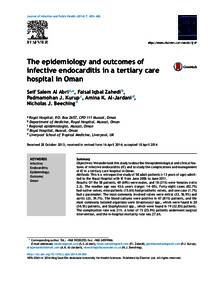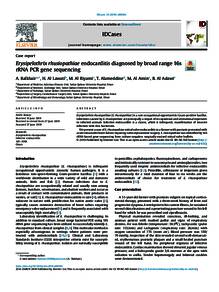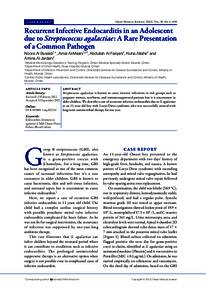Document
The epidemiology and outcomes of infective endocarditis in a tertiary care hospital in Oman.
Identifier
DOI: 10.1016/j.jiph.2014.04.004
Contributors
Zahedi, Faisal Iqbal., Author
Kurup, Padmamohan J., Author
Al-Jardaniyah, Amina K., Author
Beeching, Nicholas J., Author
Publisher
Elsevier Ltd.
Gregorian
2014-09
Language
English
Subject
English abstract
Objectives: We undertook this study to describe the epidemiological and clinical features of infective endocarditis (IE) and to study the complications and management of IE in a tertiary care hospital in Oman. Methods: This is a retrospective study of 58 adult patients (>13 years of age) admitted to the Royal Hospital with IE from June 2006 to June 2011. Results: Of the 58 patients, 40 (69%) were males, and 18 (31%) were females (ratio 2.2). The median age was 43.6 years (range: 14-85). Forty-eight cases (82.7%) had native valves, nine patients (15.6%) had prosthetic valves, and one case (1.7%) had a pacemaker. The most commonly involved valves were mitral (33, 56.9%) and aortic (23, 39.7%). The blood cultures were positive in 47 (81%) patients, and the most commonly isolated organisms were Streptococci spp., which were found in 20 (34.5%) patients, and Staphylococci spp., which were found in 19 (32.8%) patients. The complication rate was 21%. A total of 15 (25.9%) patients underwent surgical intervention, and the in-hospital mortality rate was 27.6%. Conclusions: Native-valve IE is the predominant type of endocarditis and is more of an acute disease. The prevalence of Staphylococci spp. IE is similar to that of Streptococci spp. IE, and its associated mortality remains high.
Member of
ISSN
1876-0341
Resource URL
Category
Journal articles



